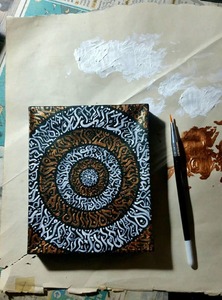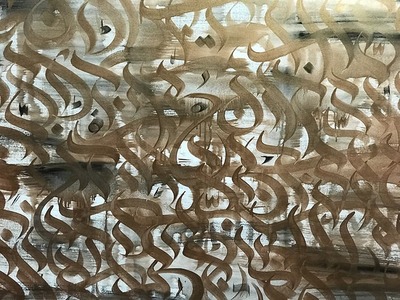Abdullah Ahmed Khan, famously known as Sanki King has been a buzzing phenomena for a long time and while he's a low key personality, his art screams 'look at me' to the world - in a good way.
We spoke to him about his journey into the art world, being a pioneer of b-boying and beat boxing, and here's what he had to say:

What led to your journey into the world of art - and more specifically calligraffiti?
I have been obsessed with drawing and painting since I was a kid and that passion was boosted further by my teachers in all the schools that I studied in, especially the last school where I graduated from. I was highly encouraged to draw and paint by not only by my art teacher in this school but also my friends at school who would bribe me to make drawings for them especially the drawing assignments of biology class. While I was still in school in 6th grade, I got introduced to graffiti, rap, beat boxing & b-boying and I was completely taken by the hip hop culture so I started copying everything I saw and listened to. I started out as a hardcore graffiti artist but on the other hand I had my father who could read and write 19 languages so I grew up with a lot of English, Urdu, Arabic, Persian, French literature and I had also grown up watching him writing the Quran in his journals and that’s where my love for languages and calligraphy comes from. A few years later when I was in 8 h grade, I started mixing the two starting with doing graffiti pieces in Urdu, Punjabi, Sindhi and then 2015 onwards I started doing calligraffiti on walls on the streets and this was a very natural transition because I am always challenging myself to produce newer and more complex works. So far I have done calligraffiti in about 9 languages and inspired to add more to the list.
How were you discovered for collaborations?
I don’t know the right answer for this question, I would say maybe my ever-aggressive and prolific attitude towards producing art created so much noise that getting attention from people in the creative industry and from the society so soon in my career, was inevitable.
Why calligraffiti?
Like I mentioned before, I grew up in a very literary family and my father was my biggest inspiration growing up, so I fell in love with letters and languages as a little kid. As I grew up as a hardcore graffiti artist I realized that I was the pioneer of this movement in Pakistan, later on I also realized that there had been no calligraffiti artists before me so I pushed this movement as well. People in this society had only seen and known Quranic calligraphy and that was it and what I was doing was unique. My knowledge of graffiti, calligraphy and languages helped shape the foundation and the structure of the calligraffiti that I have been exhibiting for the past several years and will continue to do so but that is not what I only do or have done; I have never wanted to and never wish to be known as “a graffiti artist” or “a calligraffiti artist” only, because those are very restricting labels; I just wish to be called an artist so that there are no limits to my expansion. I am an artist who is obsessed with constant self-development and creating bigger challenges for myself.

You have been called the pioneer for both calligraffiti and b boying (breakdancing) - how do the two intermix?
The time I started graffiti was also the time I started doing b-boying because both are major elements of hip hop and I watched graffiti documentaries with b-boying in them and vice versa and they are closely related. I started doing hardcore calligraffiti not until 2013 and by that time I was already doing graffiti for more than 10 years. I pioneered custom painting on sneakers as well; I am also one of the pioneers of Parkour in Pakistan; in 2018 I founded the very-first Jungian society of Pakistan. My thing is that if I like something very much to the point of having a passion for it; I just give it my ALL!! I love it, cherish it, and nourish it with every ounce of energy in my body without expecting anything in return from anything or anyone, especially any monetary benefit. And I don’t know how to not do that or if I will ever stop doing it. So more new transitions are on the way (naturally)!
What or who inspires you and your work?
I am inspired by ancient history, history of languages, symbolism, and literature. I am also deeply inspired and moved by nature, especially birds & venomous insects and reptiles. A lot of the color transitions and 3D techniques that I use are inspired from my observation of flowers and plants. I also have color synesthesia and that has always helped me greatly in expressing my thoughts & emotions sincerely through color.

If you could create a custom piece for anyone, who would it be and why? I’d like to create a custom-painted Armani suit for Mads Mikkelsen because I love Armani & Mads very much; Armani for making the best suits in the world and I fell with Mads after watching the Hannibal series because I could relate to his character very deeply.
What other styles and forms do you use in your work?
In both of my graffiti & calligraffiti pieces the inspiration comes from circles and circular forms in nature, explosions, wings of birds and rock formations. I use a lot of symbolism as well, about 4 years ago I created my own hieroglyphic language which I have been slowly mixing with my graffiti & calligraffiti pieces and in my second solo exhibition which was at Artchowk Gallery in Karachi last October, I did two full pieces of that hieroglyphic language and you would see more of it in my coming works.

Do you think it’s essential to understand the piece an artist creates or the message it’s trying to convey - it how it makes you feel?
People see what they are; whenever we look at someone or something we are subconsciously looking for a familiar reflection, we try to find ourselves in that thing or in that person. So, no matter what an artist writes or talks about their work, people will only look for themselves in that work and will like it if they see themselves in it or reject it. And since our existences are the byproduct of our mind and soul, these thoughts and feelings emanate first from our soul and mind, and then using our conscious mind we try to rationalize those emanating feelings. So in my opinion the best thing an artist can do is just let their work speak for itself.
Your graffiti is in English but looks like its Arabic, why did you choose this form?
My styles of graffiti & calligraffiti are unique in the way that I created them on my own and have never followed any guidelines of graffiti and especially traditional calligraphy. The thing that I have always put the most emphasis on and what comes the most naturally to me is “flow”; and if you look at any of my works of calligraffiti you will find a natural flow to the letters as if the letters have a life of their own and are moving on their own; hence my English calligraffiti looks Arabic because a common person’s eyes are only used to seeing “flow” in traditional Arabic calligraphy especially Arabic calligraphy.


As a fan of breakdance and hip hop, has any particular composition of either inspired you to create a piece?
I would say that the whole movement of my letters and the way I draw and paint is inspired by my years of dancing and now I make my pencils, brushes and spray paints dance under the instructions of my body and eventually the work dances.
Why the term Sanki King to represent you?
I started playing Counter Strike as a kid and my name in my team was Sanki; when I started doing graffiti I used the same name as my art moniker because I found it to be very fun and unique. I kept it because at that time I thought that Sanki meant what people commonly thing it means which is a crazy person and I could relate to my extremely curious and hyper personality but many years later I discovered through my research in Urdu literature that Sanki in Urdu means deep thinker and the name became even more relatable afterwards. As far as King is concerned, in graffiti terminology King is used for highly respected and experienced graffiti artists. I am in touch with the international graffiti community since I was 17 and I had been called King and allowed to use King next to my name by many well-renowned graffiti artists around the world. By the time I was 21, I was invited to become a part of one of the most well-known and well-respected old school graffiti crews in the world; BMK – Beyond Mankind Krew, founded in Queens, NYC in 1991. In legendary graffiti crews you are only accepted by invitation and that was a big honor for me especially to be invited by the founder of the crew himself; the legendary SMEND who has been an inspiration for hundreds of well-renowned graffiti artists in and out of the US.
What should we expect next? Bigger & better projects!

